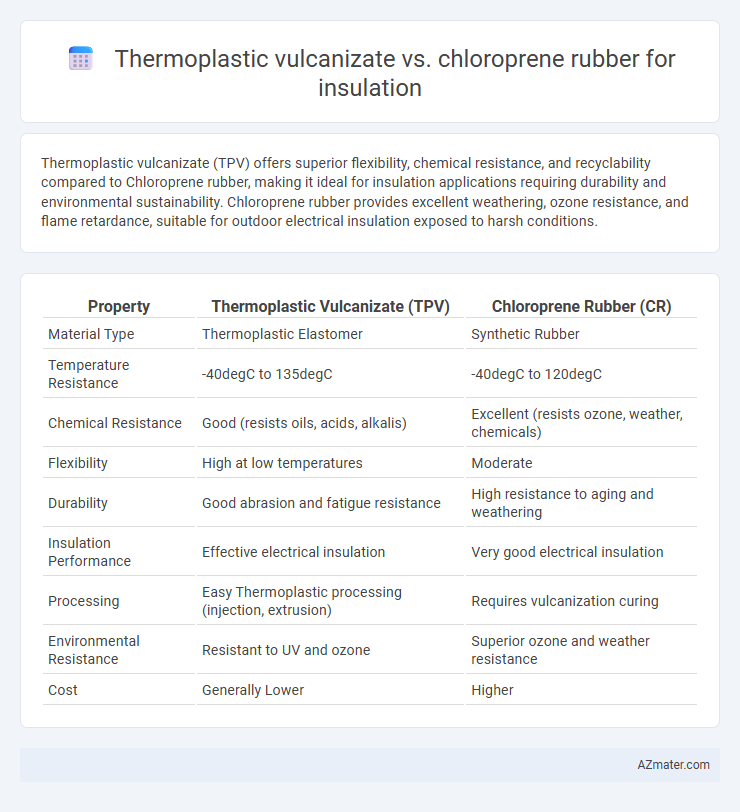Thermoplastic vulcanizate (TPV) offers superior flexibility, chemical resistance, and recyclability compared to Chloroprene rubber, making it ideal for insulation applications requiring durability and environmental sustainability. Chloroprene rubber provides excellent weathering, ozone resistance, and flame retardance, suitable for outdoor electrical insulation exposed to harsh conditions.
Table of Comparison
| Property | Thermoplastic Vulcanizate (TPV) | Chloroprene Rubber (CR) |
|---|---|---|
| Material Type | Thermoplastic Elastomer | Synthetic Rubber |
| Temperature Resistance | -40degC to 135degC | -40degC to 120degC |
| Chemical Resistance | Good (resists oils, acids, alkalis) | Excellent (resists ozone, weather, chemicals) |
| Flexibility | High at low temperatures | Moderate |
| Durability | Good abrasion and fatigue resistance | High resistance to aging and weathering |
| Insulation Performance | Effective electrical insulation | Very good electrical insulation |
| Processing | Easy Thermoplastic processing (injection, extrusion) | Requires vulcanization curing |
| Environmental Resistance | Resistant to UV and ozone | Superior ozone and weather resistance |
| Cost | Generally Lower | Higher |
Introduction to Thermoplastic Vulcanizate and Chloroprene Rubber
Thermoplastic vulcanizate (TPV) is a class of dynamic vulcanizates combining the properties of rubber and thermoplastics, offering excellent elasticity, chemical resistance, and recyclability for insulation applications. Chloroprene rubber, known as neoprene, provides superior weathering, ozone resistance, and flame retardancy, making it suitable for durable insulation in harsh environments. Both materials serve critical roles in electrical and thermal insulation, with TPV favored for flexibility and sustainability, while chloroprene excels in environmental resilience.
Material Composition and Structure
Thermoplastic vulcanizate (TPV) consists of a dynamically vulcanized blend of polypropylene and cross-linked rubber particles, offering a unique phase-separated structure that provides flexibility and heat resistance ideal for insulation applications. Chloroprene rubber (CR), a polychloroprene polymer with a covalently cross-linked network, delivers excellent chemical resistance, weather durability, and elasticity due to its stable molecular structure. The distinct material composition of TPV enables easier processing and recyclability, while chloroprene rubber's dense cross-linking ensures superior long-term mechanical performance in harsh insulating environments.
Thermal Insulation Properties
Thermoplastic vulcanizates (TPVs) exhibit superior thermal insulation properties compared to chloroprene rubber due to their enhanced resistance to heat deformation and stability at elevated temperatures. TPVs maintain flexibility and insulating performance across a wider temperature range, typically from -40degC to 150degC, whereas chloroprene rubber shows a narrower operational range with increased thermal conductivity and susceptibility to heat aging. The low thermal conductivity of TPVs combined with their excellent thermal resistance makes them ideal for applications requiring durable and effective thermal insulation.
Mechanical Strength and Durability
Thermoplastic vulcanizate (TPV) offers superior mechanical strength and enhanced durability compared to chloroprene rubber when used for insulation applications, thanks to its rubber-like elasticity combined with thermoplastic processability. TPVs exhibit excellent resistance to abrasion, fatigue, and chemical degradation, ensuring longer service life in harsh environments. Chloroprene rubber provides moderate tensile strength and weather resistance but tends to degrade faster under UV exposure and ozone, reducing its mechanical reliability over time.
Flexibility and Elasticity Comparison
Thermoplastic vulcanizate (TPV) offers superior flexibility due to its ability to retain elasticity at lower temperatures compared to chloroprene rubber, which tends to stiffen in cold conditions. TPV exhibits excellent elastic recovery and maintains flexible performance over extended service life, while chloroprene rubber provides moderate elasticity but can degrade under prolonged mechanical stress. For insulation applications requiring consistent flexibility and elasticity across varying temperatures, TPV outperforms chloroprene rubber in maintaining material integrity and resilience.
Chemical and Weather Resistance
Thermoplastic vulcanizate (TPV) offers superior weather resistance with excellent resistance to UV radiation, ozone, and oxidation, making it ideal for outdoor insulation applications. Chloroprene rubber (CR) exhibits strong chemical resistance to oils, acids, and alkalis but has moderate weather resistance compared to TPV, often degrading faster when exposed to prolonged sunlight and ozone. For environments demanding long-term chemical and weather durability, TPV's enhanced stability and flexibility make it a preferred choice over chloroprene rubber in insulation materials.
Processing and Manufacturing Methods
Thermoplastic vulcanizate (TPV) offers superior processing advantages over chloroprene rubber due to its compatibility with standard thermoplastic manufacturing techniques such as injection molding, extrusion, and blow molding, enabling faster cycle times and recyclability. Chloroprene rubber requires more complex vulcanization processes involving heat and sulfur or peroxide curing, resulting in longer curing times and less flexibility in manufacturing adjustments. TPV's thermoplastic nature allows for continuous production and easier customization of insulation thickness and shapes compared to the batch processing constraints and post-curing treatments typical of chloroprene rubber insulation.
Environmental Impact and Sustainability
Thermoplastic vulcanizates (TPVs) offer superior environmental benefits over chloroprene rubber due to their recyclability and lower energy consumption during production, reducing overall carbon footprint in insulation applications. Chloroprene rubber involves hazardous chlorine-based chemicals, posing significant challenges in waste management and potential environmental toxicity. Sustainable insulation solutions increasingly favor TPVs for their ability to be reprocessed and contribute to circular economy practices while maintaining effective thermal and electrical insulation properties.
Cost-Effectiveness and Market Availability
Thermoplastic vulcanizate (TPV) offers superior cost-effectiveness for insulation due to its recyclable nature and lower processing expenses compared to chloroprene rubber, which incurs higher raw material and curing costs. TPV's widespread market availability ensures easier sourcing and consistent supply, while chloroprene rubber faces limitations because of environmental regulations and fluctuating production capacities. Manufacturers favor TPV for scalable insulation solutions that balance performance with budget constraints across diverse industrial applications.
Application Suitability: Choosing the Right Material for Insulation
Thermoplastic vulcanizate (TPV) excels in insulation applications requiring flexibility, durability, and resistance to chemical exposure, making it ideal for automotive and electrical insulation where weather resistance and thermal stability are crucial. Chloroprene rubber (CR) offers superior flame retardancy and abrasion resistance, making it suitable for industrial environments with high mechanical stress and exposure to oils or solvents. Selecting between TPV and chloroprene rubber depends on the specific insulation demands such as temperature range, chemical exposure, and mechanical wear in the intended application.

Infographic: Thermoplastic vulcanizate vs Chloroprene rubber for Insulation
 azmater.com
azmater.com